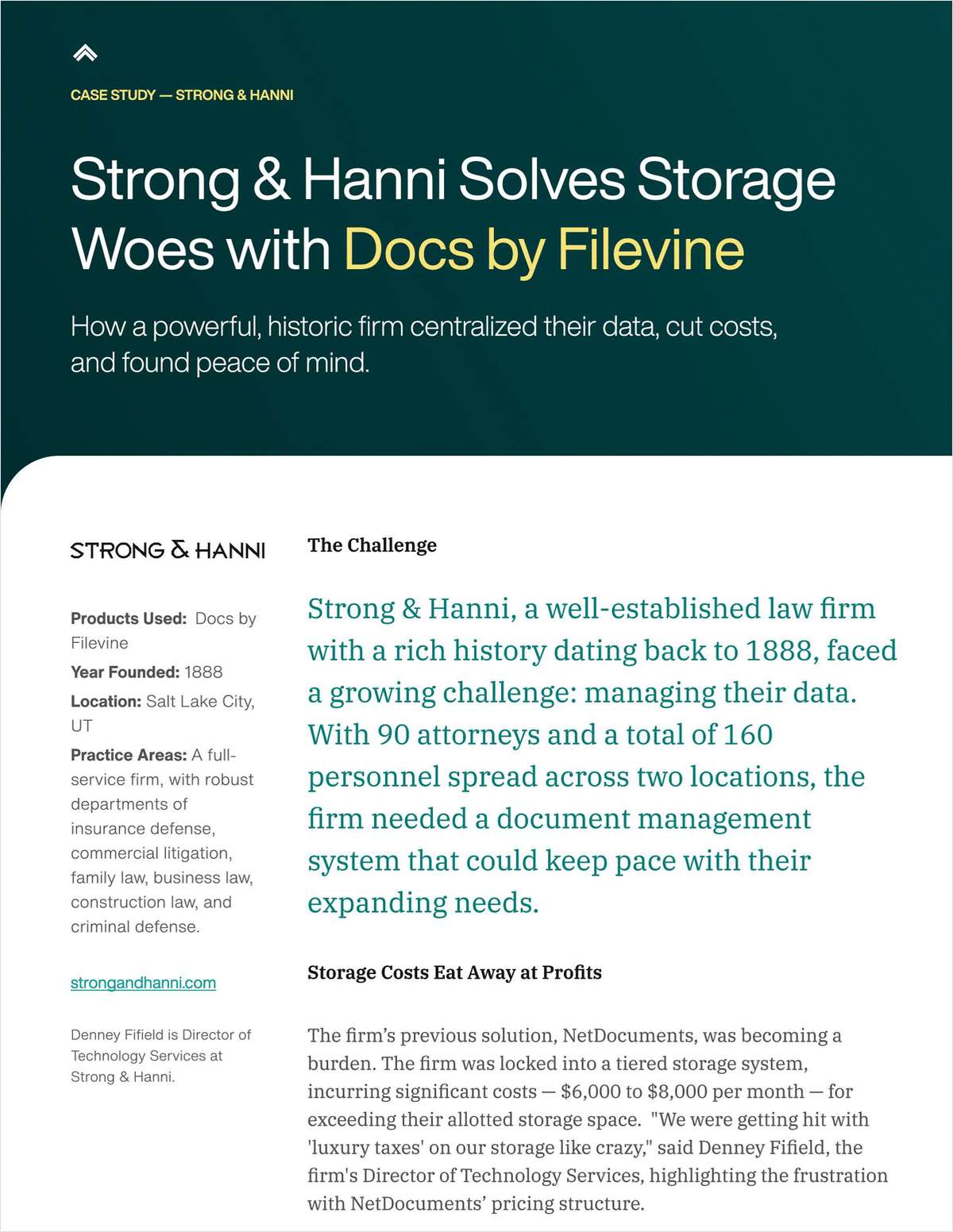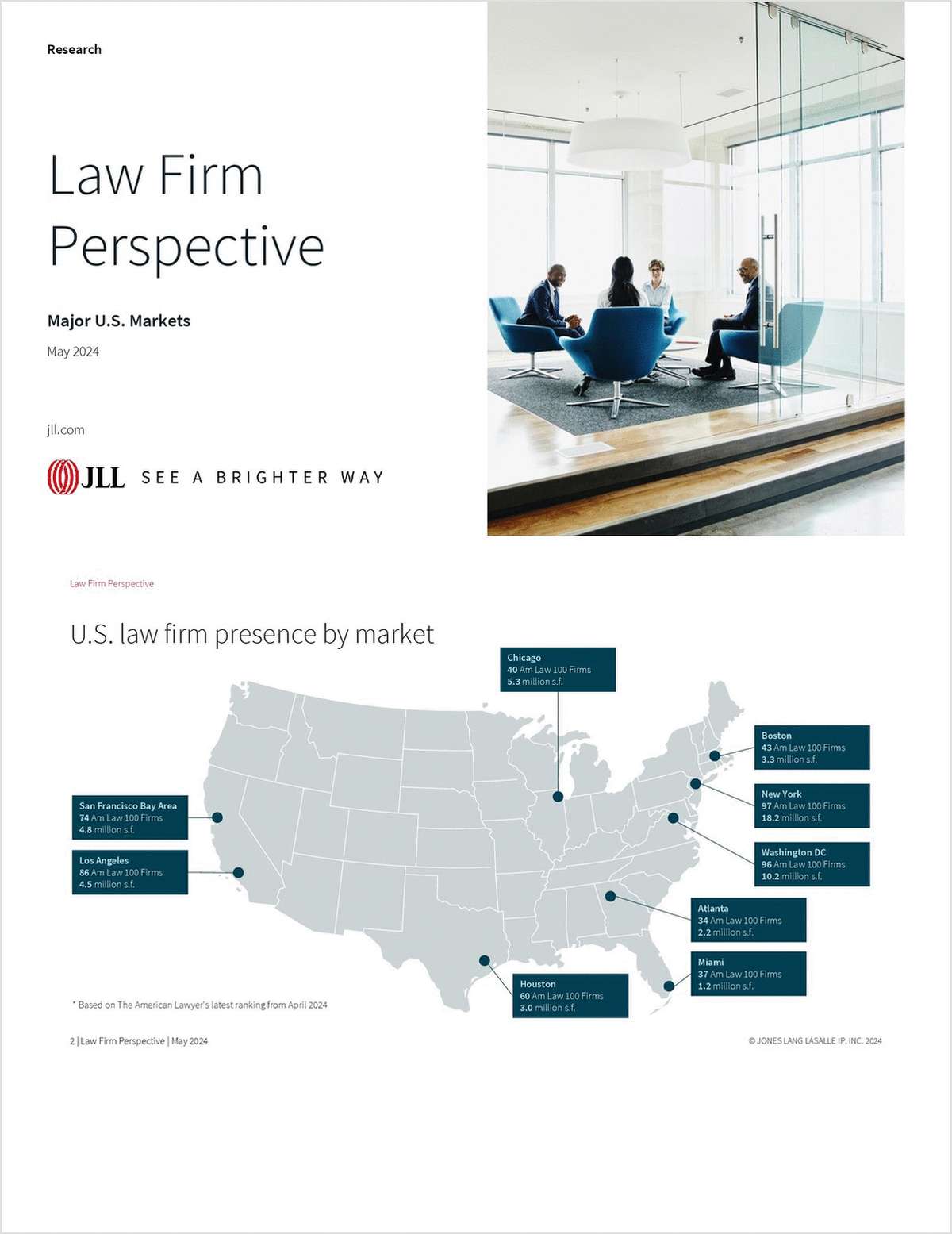 New York City. (Image: Shutterstock.com)
New York City. (Image: Shutterstock.com)Law Firm Real Estate Offers Challenges and Opportunities in Equal Measure
A long period of economic expansion has changed the way law firms navigate the market.
December 06, 2019 at 04:59 PM
4 minute read
Alternative service providers, flexible office space, rightsizing and new commercial developments are among the factors affecting the legal real estate market, according to the latest research from real estate services firm JLL.
JLL's annual Real Estate Perspective looks back at the environment for law firms at the national and local level, as well as other trends affecting the legal industry and the strategy firms should employ. For 2019, JLL identified several themes affecting law firms after nearly a decade of economic expansion, including the use of alternative service providers; whether the trend toward co-working spaces could be utilized by the legal industry; the benefits and drawbacks of resigning a lease or relocating; and the continued expansion of new law firm office space.
"The fact that we're hitting more than a decade of growth is really a surprise," said Phil Ryan, senior manager of U.S. office research for JLL. "The scale of expansion is notable, in terms of the economy [as a whole] as well as the real estate side."
The decline in students attending law school since the beginning of the Great Recession, coupled with more attorneys reaching retirement age, presents a risk to firms. However, the report said the use of alternative service providers is largely mitigating this slowdown in the workforce, meaning firms have more flexibility to utilize unique space and relocate some operations to emerging markets to attract different workers.
Rising demand for co-working spaces could affect law firms, according to JLL. That sector of the market is growing at a rate of 23% per year, with more than 82 million square feet of flexible work space in the country in 2019. That could concern law firms if it prices firms out of affordable options. It isn't a good solution for many law firms because of privacy concerns.
Many firms coming to the end of their 10- or 12-year leases will be faced with the question of whether to re-sign or relocate. In the face of an economic slowdown, the first round of rightsizing can save a firm millions in rent, but continued office space contraction can harm a firm's culture and yields less savings over time, according to JLL.
Despite some of the challenges law firms face in the real estate market, a prolonged period of economic expansion is providing them with more options for new space. There have been 119.8 million square feet of new space developed in this cycle, and millions more are under construction. As the pipeline for new development expands in the next few years, JLL said, market dynamics will become more neutral and may even shift in favor of tenants.
JLL's report identified trends in key markets for law firm growth, including Atlanta, Boston, various cities in Texas, New York, Philadelphia and more. Although fancy developments such as Manhattan's Hudson Yards have become a magnet for large firms looking to relocate or open a new outpost in a big city, upstart cities such as Phoenix and Dallas have surpassed New York and Washington, D.C., in growth, according to a report earlier in the year by CBRE.
"This really goes to show how resilient the market has been—not just in the gateway markets, but also the secondary ones," Ryan said. "There's a need for talent across the board."
As fears increase about the health of the U.S. and global economies, Ryan said it is necessary for law firms to be proactive about how they can grow in both the short and the long terms.
"There's great importance placed on long-term planning for firms and what they want their offices to be like," he said. "From a geographic perspective, you want to be amenable to younger talent. You have to have space that exceeds everyone's expectations, but also exceeds financial expectations. In order to achieve all of these things, firms must make a concerted effort to be aware of market opportunities, looking at the short term and the long term of not just the U.S. as a whole, but also where these smaller hubs are going."
Read More:
This content has been archived. It is available through our partners, LexisNexis® and Bloomberg Law.
To view this content, please continue to their sites.
Not a Lexis Subscriber?
Subscribe Now
Not a Bloomberg Law Subscriber?
Subscribe Now
NOT FOR REPRINT
© 2024 ALM Global, LLC, All Rights Reserved. Request academic re-use from www.copyright.com. All other uses, submit a request to [email protected]. For more information visit Asset & Logo Licensing.
You Might Like
View All
Big Law Communications, Media Attorneys Brace for Changes Under Trump
4 minute read

Polsinelli's Revenue and Profits Surge Amid Partner De-Equitizations, Retirements
5 minute readTrending Stories
- 1Revenue Up at Homegrown Texas Firms Through Q3, Though Demand Slipped Slightly
- 2Warner Bros. Accused of Misleading Investors on NBA Talks
- 3FTC Settles With Security Firm Over AI Claims Under Agency's Compliance Program
- 4'Water Cooler Discussions': US Judge Questions DOJ Request in Google Search Case
- 5Court rejects request to sideline San Jose State volleyball player on grounds she’s transgender
Who Got The Work
Michael G. Bongiorno, Andrew Scott Dulberg and Elizabeth E. Driscoll from Wilmer Cutler Pickering Hale and Dorr have stepped in to represent Symbotic Inc., an A.I.-enabled technology platform that focuses on increasing supply chain efficiency, and other defendants in a pending shareholder derivative lawsuit. The case, filed Oct. 2 in Massachusetts District Court by the Brown Law Firm on behalf of Stephen Austen, accuses certain officers and directors of misleading investors in regard to Symbotic's potential for margin growth by failing to disclose that the company was not equipped to timely deploy its systems or manage expenses through project delays. The case, assigned to U.S. District Judge Nathaniel M. Gorton, is 1:24-cv-12522, Austen v. Cohen et al.
Who Got The Work
Edmund Polubinski and Marie Killmond of Davis Polk & Wardwell have entered appearances for data platform software development company MongoDB and other defendants in a pending shareholder derivative lawsuit. The action, filed Oct. 7 in New York Southern District Court by the Brown Law Firm, accuses the company's directors and/or officers of falsely expressing confidence in the company’s restructuring of its sales incentive plan and downplaying the severity of decreases in its upfront commitments. The case is 1:24-cv-07594, Roy v. Ittycheria et al.
Who Got The Work
Amy O. Bruchs and Kurt F. Ellison of Michael Best & Friedrich have entered appearances for Epic Systems Corp. in a pending employment discrimination lawsuit. The suit was filed Sept. 7 in Wisconsin Western District Court by Levine Eisberner LLC and Siri & Glimstad on behalf of a project manager who claims that he was wrongfully terminated after applying for a religious exemption to the defendant's COVID-19 vaccine mandate. The case, assigned to U.S. Magistrate Judge Anita Marie Boor, is 3:24-cv-00630, Secker, Nathan v. Epic Systems Corporation.
Who Got The Work
David X. Sullivan, Thomas J. Finn and Gregory A. Hall from McCarter & English have entered appearances for Sunrun Installation Services in a pending civil rights lawsuit. The complaint was filed Sept. 4 in Connecticut District Court by attorney Robert M. Berke on behalf of former employee George Edward Steins, who was arrested and charged with employing an unregistered home improvement salesperson. The complaint alleges that had Sunrun informed the Connecticut Department of Consumer Protection that the plaintiff's employment had ended in 2017 and that he no longer held Sunrun's home improvement contractor license, he would not have been hit with charges, which were dismissed in May 2024. The case, assigned to U.S. District Judge Jeffrey A. Meyer, is 3:24-cv-01423, Steins v. Sunrun, Inc. et al.
Who Got The Work
Greenberg Traurig shareholder Joshua L. Raskin has entered an appearance for boohoo.com UK Ltd. in a pending patent infringement lawsuit. The suit, filed Sept. 3 in Texas Eastern District Court by Rozier Hardt McDonough on behalf of Alto Dynamics, asserts five patents related to an online shopping platform. The case, assigned to U.S. District Judge Rodney Gilstrap, is 2:24-cv-00719, Alto Dynamics, LLC v. boohoo.com UK Limited.
Featured Firms
Law Offices of Gary Martin Hays & Associates, P.C.
(470) 294-1674
Law Offices of Mark E. Salomone
(857) 444-6468
Smith & Hassler
(713) 739-1250











